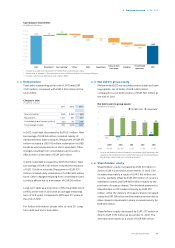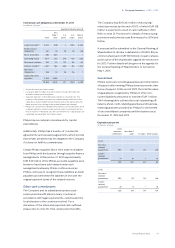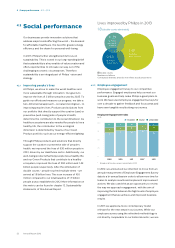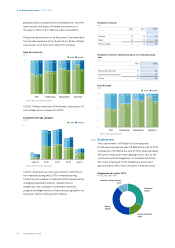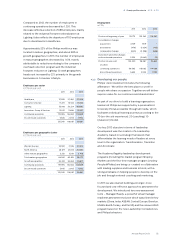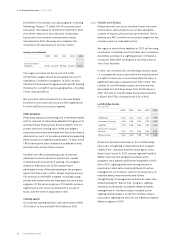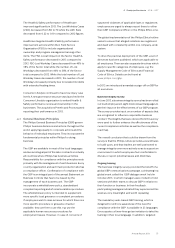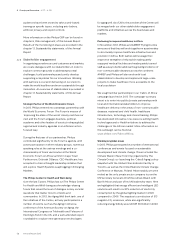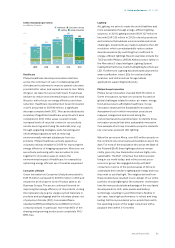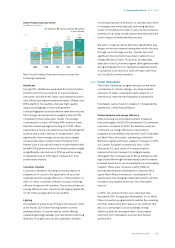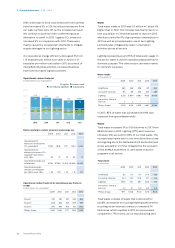Philips 2013 Annual Report Download - page 56
Download and view the complete annual report
Please find page 56 of the 2013 Philips annual report below. You can navigate through the pages in the report by either clicking on the pages listed below, or by using the keyword search tool below to find specific information within the annual report.
4 Group performance 4.2.5 - 4.2.6
56 Annual Report 2013
Enrollment in functional curricula programs, including
Marketing, Finance, IT, Sales, HR, Procurement and
Innovation, decreased to 19,000 from 24,000 in 2012.
One of the reasons for this reduction is that many
functional curricula were reviewed and content
rationalized in 2013, allowing us to redeploy the
investment into development of new content.
number of enrollments
2009 2010 2011 2012 2013
Core Curriculum
programs 5,500 20,000 39,500 43,000 32,500
The Legal curriculum hit the record of 63,000
enrollments, largely driven by the global roll-out of
mandatory Compliance programs. In 2013, we also
introduced local market programs with specific training
modules for our sta in various geographies, including
China, India and Africa.
We recorded 1,000 enrollments for the new Philips
Excellence curriculum and around 2,500 registrations
for the End2End curriculum programs.
Other programs
Philips has played a pioneering role in the Netherlands
with its national Vocational Qualification Program (CV)
and the Philips Employment Scheme (WGP). The CV
project has been running since 2004 and targets
employees who know their trade well, but do not have a
diploma to prove it. CV provides a solution by awarding
these people a recognized qualification. To date, some
1,800 participants have obtained a qualification that
will help them in their future careers.
Via WGP, we oer vulnerable groups of external
jobseekers a work experience placement, usually
combined with some kind of training. The program
started in 1983 and over 12,500 people have
participated since. After participating in the program,
about 70% find a job. In 2013, Philips employed some
150 persons via the WGP program, including young
people with autism who are training to become a test
engineer. Of the previous group of 10 autistic persons,
eight found a job, one proceeded with a course of
study, and the other is applying for jobs.
Training spend
Our external training spend in 2013 amounted to EUR
47.3 million, in line with EUR 46.9 million in 2012.
4.2.6 Health and Safety
Philips strives for an injury-free and illness-free work
environment, with a sharp focus on decreasing the
number of injuries and process improvements. This is
defined as a KPI, on which we set yearly targets for the
company and our individual sectors.
We regret to report three fatalities in 2013, all involving
contractors. In Pakistan and Colombia, two contractors
died while working on a Lighting project. In Poland a
contractor died while working on a reconstruction at
one of our factories.
In 2013, we recorded 307 Lost Workday Injuries cases,
i.e. occupational injury cases where the injured person
is unable to work one or more days after the injury, a
significant decrease compared with 345 in 2012. The
number of Lost Workdays caused by these injuries
amounted to 9,603 days down from 12,630 days in
2012. The rate of Lost Workday Injuries decreased to
0.28 per 100 FTEs compared with 0.31 in 2012.
Lost Workday Injuries
per 100 FTEs
2009 2010 2011 2012 2013
Healthcare 0.20 0.25 0.20 0.22 0.19
Consumer Lifestyle 0.26 0.26 0.23 0.25 0.24
Lighting 0.76 0.80 0.64 0.45 0.41
Innovation, Group &
Services 0.07 0.13 0.04 0.05 0.04
Philips Group 0.44 0.50 0.38 0.31 0.28
All sectors showed a decrease in the Lost Workday
Injury rate. At Lighting, a dedicated action program,
“Safety First”, was launched five years ago to drive
down injury levels. In 2012, various regional Health &
Safety improvement programs and peer audit
programs were started and further expanded in 2013.
Since 2010, Lighting achieved a strong decline in
reported accident rates mainly attributed to active
management involvement, launch of a new policy on
machine safety improvements and further
strengthening of management systems at major sites
implementing the “Safety First” program. Lighting
initiated a work stream to address Health & Safety
management in Turnkey projects, headed by the
Lighting market leaders. In eorts to further reduce
injury rates, Lighting will also roll-out a Behavior Based
Safety program in 2014.





